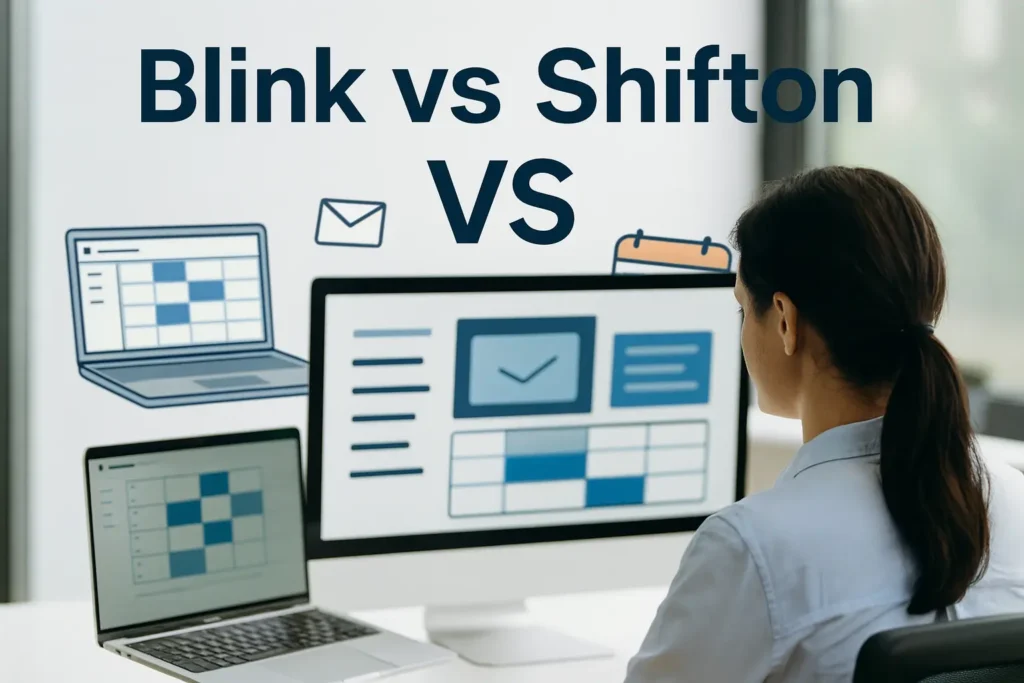In 2025, teams are no longer satisfied with basic chats and digital bulletin boards. They need platforms that solve real problems: from shift scheduling and time tracking to seamless communication and performance analytics.
Two popular platforms are making waves: Blink and Shifton. Both claim to simplify teamwork and boost engagement. But which one actually delivers?
In this honest comparison, we’ll break down where Blink shines, where it falls short, and how Shifton stacks up as a true all-in-one workforce management solution.
What is Blink and Why Do Companies Use It?
Blink is a workforce communication platform that includes:
A social-media style newsfeed
One-on-one and group chat
A content hub for internal knowledge
Surveys and polls
Basic integrations with HR and cloud tools
Blink aims to connect everyone in the company—from the C-suite to frontline staff—in one clean, mobile-friendly space.
What Blink does well:
Clean, intuitive interface
Easy onboarding with employee profile sync
Group segmentation by role or location
SSO support and basic security features
Where Blink falls short:
No collaboration or task management tools
No time tracking or scheduling features
Limited analytics and data reporting
Minimal automation or workflow logic
Blink vs. Shifton Feature Breakdown
While Blink focuses on communication, Shifton is built for full-spectrum workforce coordination. Here’s how they compare:
1. Communication
Blink: Focused on messaging, newsfeeds, and basic surveys
Shifton: Integrated notifications tied to shift changes, HR events, and approvals
2. Scheduling & Time Management
Blink: No shift planner or time tracking
Shifton: Advanced scheduling engine with labour law compliance, break tracking, shift swaps, and workload balance
3. Integrations & API Access
Blink: Limited integrations (only in Enterprise plan)
Shifton: Open API + native integrations with payroll, HRMS, calendars, CRM
4. Analytics & Automation
Blink: Basic employee surveys only
Shifton: Live dashboards, shift cost analysis, time-on-task tracking, automation for repetitive HR tasks
Blink Pricing: What’s the Deal?
Blink uses a quote-only pricing model. There are two plans:
Business: Core features, limited surveys, 24/7 support
Enterprise: Includes API, advanced survey tools, SharePoint and Box integration
According to public data, Blink’s Business plan starts around £3.40/user/month, but you can’t access a free trial without speaking to a rep.
Issues with Blink pricing:
No clear pricing on the website
Sales team is slow to respond
No transparent onboarding for trials
Shifton, on the other hand, offers:
A free-forever plan for small teams
Fixed-price tiers by number of users
Self-serve trial with instant setup
What Users Are Saying: Blink vs. Shifton in Real Life
Blink is praised for its mobile UI and ease of use. But many users complain about:
Lack of advanced functionality
Poor customer support
Inability to generate reports or track engagement effectively
Shifton earns loyalty for:
Powerful shift automation tools
Support for complex workflows and labour rules
Transparent billing and instant access
All-in-one functionality that reduces tool switching
Who Should Use Blink? Who Should Choose Shifton?
Choose Blink if:
You only need messaging and announcements
Your team is under 50 people
You’re looking for a basic, mobile-first internal feed
Choose Shifton if:
You manage shift workers or hybrid teams
You want built-in scheduling, time tracking, and HR tools
You need real-time insights on workforce productivity
You’re growing fast and need scalable structure
The Verdict: Blink or Shifton in 2025?
If you’re only solving for communication, Blink can work. But for businesses managing schedules, labour compliance, and operational efficiency, Shifton is the clear winner.
Shifton isn’t just a communication layer. It’s a true workforce OS that replaces spreadsheets, disconnected apps, and manual scheduling with automation and structure.
Conclusion
Blink has its place in the market. It’s sleek, simple, and does a good job at keeping teams informed. But in today’s fast-moving business world, simplicity alone doesn’t cut it.
Shifton is built for companies that want control, visibility, and automation in every part of the workforce journey—from hiring to planning to analytics.
If you’re ready to move beyond chat apps and newsfeeds, it’s time to shift to something more powerful.

 English (US)
English (US)  English (GB)
English (GB)  English (CA)
English (CA)  English (AU)
English (AU)  English (NZ)
English (NZ)  English (ZA)
English (ZA)  Español (ES)
Español (ES)  Español (MX)
Español (MX)  Español (AR)
Español (AR)  Português (BR)
Português (BR)  Português (PT)
Português (PT)  Deutsch (DE)
Deutsch (DE)  Deutsch (AT)
Deutsch (AT)  Français (FR)
Français (FR)  Français (BE)
Français (BE)  Français (CA)
Français (CA)  Italiano
Italiano  日本語
日本語  中文
中文  हिन्दी
हिन्दी  עברית
עברית  العربية
العربية  한국어
한국어  Nederlands
Nederlands  Polski
Polski  Türkçe
Türkçe  Українська
Українська  Русский
Русский  Magyar
Magyar  Română
Română  Čeština
Čeština  Български
Български  Ελληνικά
Ελληνικά  Svenska
Svenska  Dansk
Dansk  Norsk
Norsk  Suomi
Suomi  Bahasa
Bahasa  Tiếng Việt
Tiếng Việt  Tagalog
Tagalog  ไทย
ไทย  Latviešu
Latviešu  Lietuvių
Lietuvių  Eesti
Eesti  Slovenčina
Slovenčina  Slovenščina
Slovenščina  Hrvatski
Hrvatski  Македонски
Македонски  Қазақ
Қазақ  Azərbaycan
Azərbaycan  বাংলা
বাংলা 

